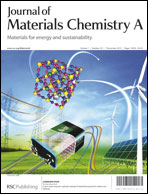Brief air heating of TiO2/dye films, to 120–250 °C; the effect on resulting liquid junction dye sensitised solar cells (DSSCs) and melt-processed solid-state DSSCs†
Abstract
TiO2/Z907 and TiO2/D149 films have been subjected to 1 minute heating in room air to 120 °C, 190 °C, and 255 °C. Liquid electrolyte dye-sensitised solar cells (DSSCs), fabricated after the heating step, are used to assess the damage to the TiO2/dye film by the heat. N,N′-bis(3-methylphenyl)-N,N′-diphenylbenzidine (TPD) and spiro-OMeTAD (SOT) hole conductors are also melt processed onto the TiO2/dye films, requiring 190 °C and 255 °C respectively. The hole conductors have been removed by dissolution and liquid electrolyte DSSCs have been fabricated from the TiO2/dye films. The effect of the 120 °C heat step is minimal. After 190 °C heating the efficiency loss is 10–20% depending on dye and film thickness. After 255 °C heating the efficiency loss is from 27 to 65%. The loss of efficiency occurs almost entirely due to a decrease in recombination lifetime, up to 100 fold in the worst case. This causes a decrease in Voc, and also in collection efficiency for thicker films. Solid state DSSCs made with melt processed spiro-OMeTAD on 2 μm TiO2/Z907 films are shown, with efficiency of 0.45%. Efficiency is limited by a thick capping layer and base (4-tert-butylpyridine, TBP) boil-off during processing.


 Please wait while we load your content...
Please wait while we load your content...